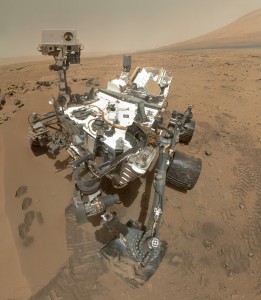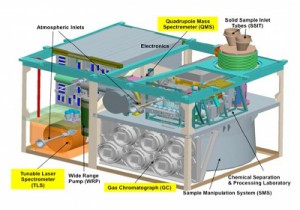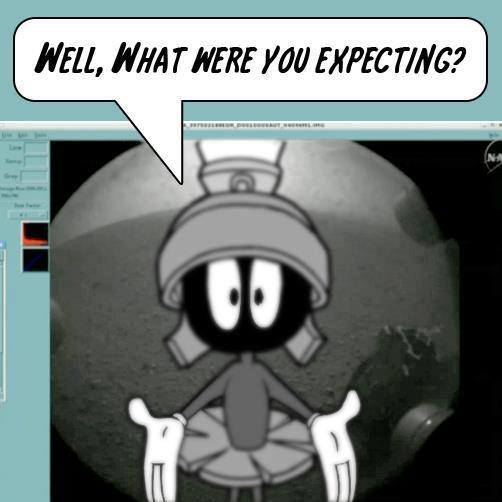There is something that Curiosity, the Martian rover, discovered in the last week that is creating a stir, but the NASA team is keeping things under wraps before officially going public. John Grotzinger, the principal investigator for the Martian science mission at Caltech in Pasadena, California, describes data from the on board chemistry lab as “one for the history books.” But what the rover has found needs to be verified through a series of multiple checks to make sure it is real.

What are we talking about here? The instrument involved is affectionately called SAM which stands for Sample Analysis at Mars. SAM has three different laboratory tools, all improvements over the instrumentation that the Viking landers used in their initial attempts in 1976 to find evidence of past life on Mars.
One tool is a mass spectrometer which separates elements and compounds by mass for identification and measurement.
The second is a gas chromatograph which vaporizes soil and rock samples to analyze the gases they emit.
The third is a tunable laser spectrometer which measures various isotopes of carbon, hydrogen and oxygen in sampled Martian atmospheric gases. The laser spectrometer is the principal tool searching for methane and water vapour.
Measurement by these tools is accurate to within 10 parts per thousand. SAM, therefore, is in the business of finding compounds essential for life both past and present and by sampling Martian rocks, soil and atmosphere, can come very close to telling us if there is life on Mars today.

That “one for the history books” statement, in light of what we know SAM is analyzing, leads to some interesting speculation. I don’t know about you, but Curiosity is a mere 107 days into its mission and may already have contributed to what may prove to be the definitive moment in our understanding of the existence of life in the Universe. I can’t wait to hear more. The official announcement is planned for the American Geophysical Union’s fall meeting in San Francisco starting the week of December 3rd.
Stay tuned!

















((The official announcement is planned for the American Geophysical Union’s fall meeting in San Francisco starting the week of December 3rd.))
If NASA announces the Curiosity SAM package data is indicating precisely what we should expect from desiccated wallaby droppings on Mars, then I would suppose that is big, but bad, news. The, “Save the Martian wallaby,” and “Let’s put men on Mars” crowds will be screaming for a hurry-up manned mission to Mars. The politics would be nearly irresistible, and a hundred billion or so dollars, sorely needed for robotic AI and hermetic life-support systems development, will be wasted on mainly pointless manned missions. NASA is acting like the carnival sideshow barker. “Hurry, Hurry, step right up, the astonishing Martian wallaby belly dancers are about to start their tantalizing hoochee-cootchee act.”
The Kepler mission has probably been a fair investment, but NASA has yet to release the data on Earth-sized water-world planets orbiting Sol type stars. That’s the most significant data. How many 7-8 billion old Sols with water-world planets are there? I’m guessing there are scores within 15,000 light-years.
The JWST will likely come in way over budget, but it will settle many of the astrophysical questions. The asteroid belt composition and metallic element differentiation are the most important space questions. The answers will decide whether human kind is destined to be a planet bound species. Only AI robots can answer the questions and exploit the resources of the asteroid belt.
What is the business about the recent detection of a rogue planet? I have long thought it likely that the Milky Way Galaxy contains more rogue planets roaming randomly through interstellar space than it does planets orbiting stars in relatively stable solar orbits. Seems likely that planets formed at the origins of most binary and trinary star systems. Many or most of these planets formed in unstable orbits, and were destined for eventual expulsion from their solar orbits. Now, in vast numbers exceeding the stars, they coast endlessly through interstellar space, awaiting some eventual chance gravitational encounter with a distant solar system.
I am not convinced that finding evidence of life in the past or present on Mars will lead to a sudden push to put humans on Mars. But I believe that follow up robotic missions that are true biological laboratories on wheels will finally get funded. SAM doesn’t definitively detect biology. All the evidence is indirect.
I figured that Curiosity found a Twinkie…;-)
Jimmy
Interesting speculation considering the company has decided to end the run. What I keep thinking is what if they found an artifact that appears to not be naturally made? That would be even better than finding organic molecules or evidence of living bacteria. But thanks for the Twinkie contribution. I preferred the cupcakes myself.
((What I keep thinking is what if they found an artifact that appears to not be naturally made? That would be even better than finding organic molecules or evidence of living bacteria. ))
Well it would sure be a lot more interesting; but the “even better” proposition seems problematic. A rusty bicycle chain sprocket would probably cost the taxpayers $500-billion for a hurry-up manned mission. Competent sentient robots are probably a decade away. For my money we can wait the decade and do it smart.